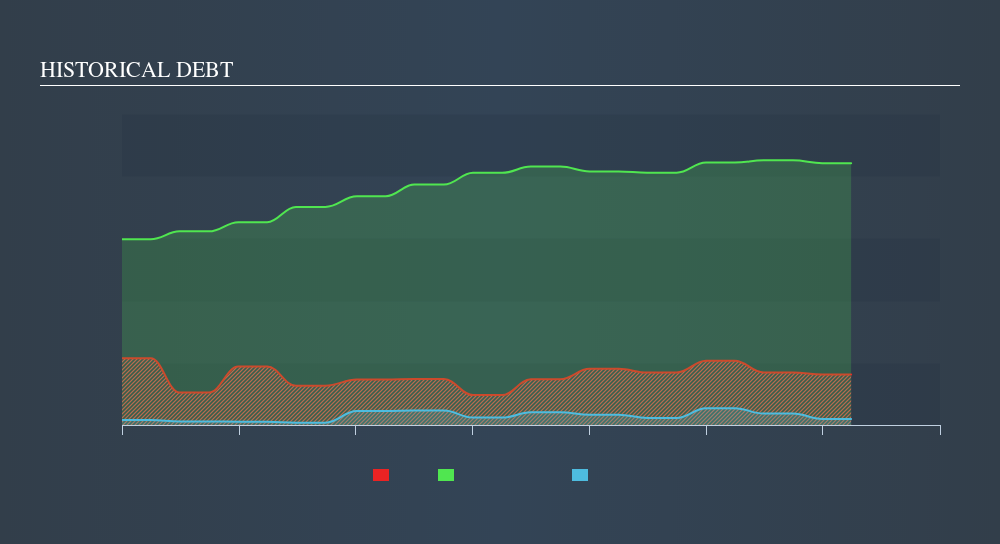- United Kingdom
- /
- Specialty Stores
- /
- LSE:HFD
Halfords Group (LON:HFD) Has A Somewhat Strained Balance Sheet

Legendary fund manager Li Lu (who Charlie Munger backed) once said, 'The biggest investment risk is not the volatility of prices, but whether you will suffer a permanent loss of capital. It's only natural to consider a company's balance sheet when you examine how risky it is, since debt is often involved when a business collapses. We can see that Halfords Group plc (LON:HFD) does use debt in its business. But is this debt a concern to shareholders?
When Is Debt A Problem?
Generally speaking, debt only becomes a real problem when a company can't easily pay it off, either by raising capital or with its own cash flow. If things get really bad, the lenders can take control of the business. While that is not too common, we often do see indebted companies permanently diluting shareholders because lenders force them to raise capital at a distressed price. Of course, debt can be an important tool in businesses, particularly capital heavy businesses. The first step when considering a company's debt levels is to consider its cash and debt together.
View our latest analysis for Halfords Group
What Is Halfords Group's Net Debt?
You can click the graphic below for the historical numbers, but it shows that Halfords Group had UK£81.0m of debt in March 2019, down from UK£114.8m, one year before. However, it does have UK£9.80m in cash offsetting this, leading to net debt of about UK£71.2m.

How Strong Is Halfords Group's Balance Sheet?
The latest balance sheet data shows that Halfords Group had liabilities of UK£214.7m due within a year, and liabilities of UK£106.5m falling due after that. Offsetting this, it had UK£9.80m in cash and UK£26.7m in receivables that were due within 12 months. So its liabilities outweigh the sum of its cash and (near-term) receivables by UK£284.7m.
This deficit is considerable relative to its market capitalization of UK£325.0m, so it does suggest shareholders should keep an eye on Halfords Group's use of debt. This suggests shareholders would heavily diluted if the company needed to shore up its balance sheet in a hurry.
We use two main ratios to inform us about debt levels relative to earnings. The first is net debt divided by earnings before interest, tax, depreciation, and amortization (EBITDA), while the second is how many times its earnings before interest and tax (EBIT) covers its interest expense (or its interest cover, for short). The advantage of this approach is that we take into account both the absolute quantum of debt (with net debt to EBITDA) and the actual interest expenses associated with that debt (with its interest cover ratio).
Halfords Group's net debt is only 0.82 times its EBITDA. And its EBIT covers its interest expense a whopping 22.2 times over. So we're pretty relaxed about its super-conservative use of debt. On the other hand, Halfords Group's EBIT dived 17%, over the last year. If that rate of decline in earnings continues, the company could find itself in a tight spot. When analysing debt levels, the balance sheet is the obvious place to start. But it is future earnings, more than anything, that will determine Halfords Group's ability to maintain a healthy balance sheet going forward. So if you want to see what the professionals think, you might find this free report on analyst profit forecasts to be interesting.
Finally, a company can only pay off debt with cold hard cash, not accounting profits. So we always check how much of that EBIT is translated into free cash flow. During the last three years, Halfords Group produced sturdy free cash flow equating to 57% of its EBIT, about what we'd expect. This free cash flow puts the company in a good position to pay down debt, when appropriate.
Our View
Halfords Group's EBIT growth rate and level of total liabilities definitely weigh on it, in our esteem. But the good news is it seems to be able to cover its interest expense with its EBIT with ease. Taking the abovementioned factors together we do think Halfords Group's debt poses some risks to the business. So while that leverage does boost returns on equity, we wouldn't really want to see it increase from here. Given Halfords Group has a strong balance sheet is profitable and pays a dividend, it would be good to know how fast its dividends are growing, if at all. You can find out instantly by clicking this link.
At the end of the day, it's often better to focus on companies that are free from net debt. You can access our special list of such companies (all with a track record of profit growth). It's free.
We aim to bring you long-term focused research analysis driven by fundamental data. Note that our analysis may not factor in the latest price-sensitive company announcements or qualitative material.
If you spot an error that warrants correction, please contact the editor at editorial-team@simplywallst.com. This article by Simply Wall St is general in nature. It does not constitute a recommendation to buy or sell any stock, and does not take account of your objectives, or your financial situation. Simply Wall St has no position in the stocks mentioned. Thank you for reading.
About LSE:HFD
Halfords Group
Through its subsidiaries, provides motoring and cycling products and services in the United Kingdom.
Undervalued with excellent balance sheet.
Similar Companies
Market Insights
Community Narratives





